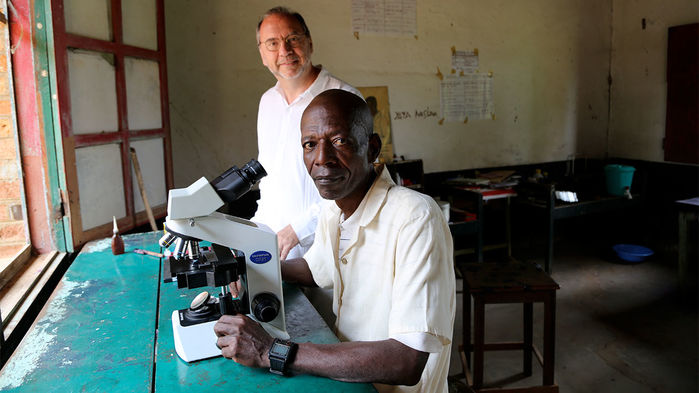Forty years after the first documented Ebola outbreak, some of the survivors still have antibodies against the virus, a new study reveals. The find bolsters the widely held assumption that Ebola survivors remain immune to the virus for life. The work may also help guide development of new medicines and clarify the long-term health consequences of an Ebola infection.
In 1976, Ebola struck Yambuku, a small village in the northeast corner of the Democratic Republic of the Congo (DRC). Of the 318 recorded cases, 280 people died. Epidemiologist Anne Rimoin of the University of California, Los Angeles, who has a lab in the DRC’s Kinshasa, in 2014 organized a trip to Yambuku with some of the researchers who responded to the 1976 outbreak, including epidemiologist Peter Piot, the co-discoverer of the Ebola virus. The group was not planning on doing research—they were creating a documentary on epidemics—but Rimoin, who has worked in the DRC for 15 years investigating emerging infectious diseases, became intrigued by the idea of studying the survivors from 1976. “No one thought it would be possible to find them,” says Rimoin, who saw an opportunity to better understand how long immunity to Ebola persists. Other studies have examined immune responses of Ebola survivors from infections dating back only 11 years.
With help from the original outbreak investigators and Sukato Mandzomba, a lab technician who was among those infected that lived (and still works in the local hospital), Rimoin and her team tracked down survivors, ranging in age from 55 to 86, who were willing to give blood samples. Their analysis of those samples appears online today in The Journal of Infectious Diseases. “I am very excited about this paper as it illustrates how a combination of working together, being present locally, and—perhaps above all—the power of long-term friendship, can produce these long-term data,” says co-author Piot, who now heads the London School of Hygiene & Tropical Medicine.
Obtaining the blood samples was complicated. Rimoin and her team flew to Bumba, 1000 kilometers from Kinshasa, on a chartered plane, and then drove 100 kilometers on dirt roads to the forested area of Yambuku. They traveled with an electrician, a –80°C freezer, a refrigerated centrifuge, liquid nitrogen, and long-lived batteries to run their generators. They then shipped blood samples back to Kinshasa, some of which were sent to collaborators in the United States to run various immunologic tests.
All survivors had antibodies that reacted, some very strongly, to three different Ebola proteins, the team reports. Four people had antibodies that went beyond simply binding to the proteins but could “neutralize” the virus—rendering it noninfectious—in lab experiments. “That was shocking,” says Gene Olinger, an immunologist with MRIGlobal in Frederick, Maryland, who ran some of the tests. “I’d thought we’d have responses but I didn’t think we’d see neutralizing antibodies or the other strong responses.”
No documented case exists of an Ebola survivor becoming infected a second time, and virologist Diane Griffin of Johns Hopkins Bloomberg School of Public Health in Baltimore, Maryland, who specializes in RNA viruses such as Ebola, says they typically confer lifelong immunity. “I do not find these results surprising,” Griffin says. Yet she says many questions remain about how long-term immunity is established and maintained, which is “certainly worthy of study” and relevant to vaccine development.
Olinger, who previously studied Ebola in monkeys when he worked with the U.S. military, counters that he does not think lifelong protection is a given. In his experience, some animals that became ill after being intentionally infected with Ebola and recovered, have later been infected again with the virus and died. Nonetheless, he’s anxious to do more studies, possibly in animals, with the blood from the survivors to try help tease out the specific immune responses that could be key to vaccine developers. “There’s so much more work to do,” he says.
One of the most important aspects of the new work, says Olinger, is that the identification of long-term Ebola survivors will give hope to the some 17,000 people in West Africa who contracted virus between 2013 to 2016 and did not die from the infection. “Survivors felt their lives would be shortened by the disease,” says Olinger, who worked in West Africa during that epidemic.
Rimoin and her collaborators are now further studying the 14 survivors from the 1976 outbreak to assess whether they had long-term health consequences from their Ebola infections. The team has also begun collecting blood samples from 40 survivors of an outbreak that occurred in Kikwit in 1995. “The aperture for studying these people is closing,” says Rimoin, who notes that people in the DRC have one of the shortest life expectancies in the world, 58 for men and 62 for women. “There’s a lot to learn from them.”
